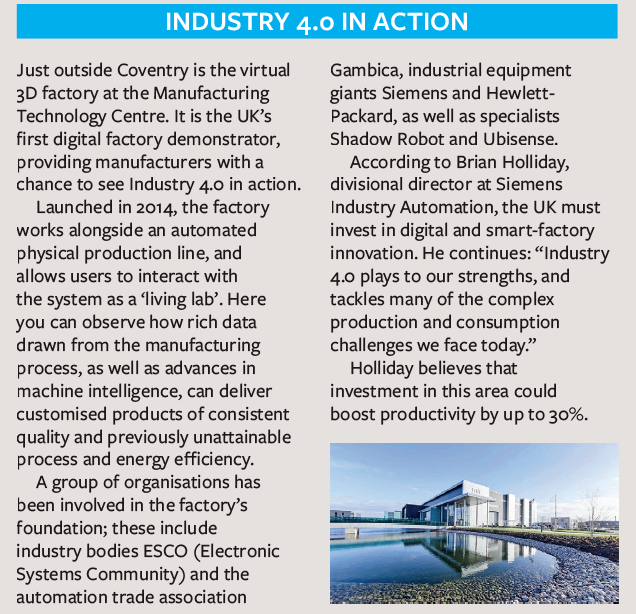Inside Amberg: Industry 4.0 in action

A fourth industrial revolution is upon us. The early signs are that managers are far from being redundant
Massimo BarbatoEmployees walk quietly across marble-patterned floors, their blue overalls blending in with the surroundings. Tall machine cabinets stand in rows. Between them are monitors displaying torrents of data.
The factory floor at Siemens Electronics in Amberg, Germany, could easily be mistaken for an operating theatre. Everything is germ-free in this utterly digital world. Opened in 1989, the plant produces programmable logic controls (PLCs) used to automate machines such as ski-lifts and cruise ships’ on-board systems, as well as industrial manufacturing processes.
The factory is recognised worldwide for its pioneering automation. In an average year (230 working days), it produces 12 million PLCs – that’s one control unit per second, and production quality at the factory is at 99.99885%.
“I don’t know of any comparable plant worldwide that has achieved such a low defect rate,” says Professor Karl-Heinz Büttner, who heads the plant.
Only at the start of the manufacturing process is anything touched by human hands. A Siemens employee places the initial component (a bare circuit board) on a production line. From this point, everything runs automatically, with machines and computers handling 75% of the value chain on their own.
Products even control their own manufacturing processes, using a unique barcode to communicate and share requirements with other production robots. Astonishingly, an individual PLC can take corrective action to avoid damage in the production process, and automatically replenishes individual parts in order to meet delivery deadlines.
Industry 4.0 – the new landscape
For many, the emergence of digital factories heralds the start of a fourth industrial revolution, Industry 4.0.
In this new industrial landscape, the cyber world merges with the physical to become a vast information network – an ‘industrial internet’ or ‘internet of things’ (IoT) that will connect human and machine activity.
At a fundamental level, IoT shifts the way manufacturers and engineering firms think, and could reap huge, production-related rewards – the flexible, self-organising factory, for one.
When everyone, including the factory, is connected to the internet, it becomes possible for the manufacture of custom-made products to be as cheap as mass production.
The consequences are profound. Since low labour costs are no longer a priority in the digital factory, off shore production is likely to return to rich countries, to be closer to the markets they serve. This localised manufacturing will mean shorter, less costly supply chains and, in the long term, less environmental pollution.
Research published by management consultancy McKinsey & Company in June 2015 showed that, for the manufacturing sector alone, IoT has a potential value of between $1.2 trillion (£779 billion) and $3.7 trn (£2.4 trn) per year by 2025.
But what impact will IoT have on the manufacturing value chain? And, most intriguing of all, how will automated manufacturing shape the future of management?
This is where the Amberg story sheds some light.
Efficient machines and employees with ideas
Reassuringly, Büttner says that “we are not planning to create a workerless factory”. Some 300 people work during a shift at the Amberg plant, and it has a total of about 1,100 employees.
The machines may be efficient in performing tasks, but they don’t come up with ideas for improving the system itself. Current industrial robots and machines are limited by their inability to recognise patterns, and their lack of common sense. At the plant, technicians sit in computerised workstations where they can view the entire production process, making many key decisions to ensure that it runs smoothly.
At Amberg, Siemens relies on the creativity of employees to write code for new software, find patterns in data, develop and design products, plan production runs, market innovations, and handle unexpected incidents.
Büttner believes that manufacturing challenges are overcome only “with a modern, highly flexible production environment and through cooperation and constant information exchange”. And only human intervention can close this loop.
Great managers provide the inspirational leadership and knowledge of the latest digital technologies; they set high-quality standards and embed excellent communication systems.
They also establish the incentives to encourage entrepreneurship. At Amberg, it is people who generate the new ideas from the factory’s flow of ‘big data’, with employee-suggested improvements accounting for 40% of annual productivity increases at the plant (the remaining 60% comes through investment in infrastructure).
“Employees are much better than management at determining what works or doesn’t work in the daily operation and how processes can be optimised,” says Büttner. In 2013, the plant adopted 13,000 of these ideas and rewarded employees with payments totalling around €1 million (£734,000).
Managers had created an environment that encourages such initiatives.

Over time, humans and robots will work even more closely. Human-robot workstations will evolve, tearing down the wall between man and machine. The goal of AI scientists such as Professor Michael Zäh at the Technical University of Munich is to create robots that think for themselves and can liberate people from difficult and dangerous tasks.
“Our vision is for robots to become colleagues for humans,” says Zäh. “At the moment, they are productive, while people are flexible; we want to combine the best of both worlds.”
To some degree, this human-robot interaction is already happening. Amberg’s IoT systems record and control the production process from start to finish; computer software defines all of the manufacturing processes and commands, and directly updates these processes with the latest data.
However, it is the Siemens’ R&D department that has turned this data into the 1,000 different products that are manufactured at the plant.
It has been estimated that up to 50% of today’s conventional automated machinery needs to be upgraded or replaced, yet in June 2015, the European Commission reported that a mere 1.7% of companies in the EU make full use of advanced digital technologies.
But ignorance is not a viable management response. Like other developments in technology, IoT lowers the barriers for smaller and more innovative competitors to enter markets and disrupt traditional business models. Arizona-based Local Motors, for example, builds cars almost entirely through 3D printing, with a design crowdsourced from an online community.
It can use a digital file to build a new model from scratch in a year; the industry average is six.
The digital factory is primarily a data-driven environment, where managers must get to grips with big data: how to collect it, analyse it and use it to optimise the manufacturing value chain.
At the Amberg plant, more than 1,000 scanners document all the manufacturing steps in real time, and 50 million pieces of process data are generated daily to inform management decision-making.
In the future, companies will know almost immediately how many people have downloaded or viewed their products.
This will enable data-savvy, hyper-responsive, customer-focused marketers to target their audiences with tailor-made specifications – but it also raises complex data security and privacy questions that, again, will need human judgement to resolve.
Intellectual capital – the key to unlocking IoT’s potential
How should managers prepare for a digital transformation? They can start by collecting lots more data, joining the hunt for the best digital talent, retraining existing staff and thinking about how to structure a digital organisation.
“Technology is shaking the very foundations of 21st-century capitalism, by making skills and knowledge the only sources of sustainable strategic advantage,” Massachusetts Institute of Technology economist Lester Thurow has said.
In a cyber-physical economy, he continues, “success or failure will depend upon whether a country is making a successful transition to the man-made brainpower industries of the future – not on the size of any particular sector.”
To make this happen, we need entrepreneurs who will create new industries and new wealth from technological innovations. The energy and vitality of these people must be unleashed, they must be allowed to inject new leadership, and the education system will need an overhaul, especially in science and technology.
Ultimately, the impact of Industry 4.0 goes beyond reshaping the economic order of things. Mass customised, automated manufacturing has the potential to touch the heart of what makes us human, by bringing the gift of imagination to life.
The effects of this will have far-reaching consequences for society as a whole.
This article was first published in the Autumn issue of Professional Manager – out now
Illustration by Charles Williams

Press & Media Enquiries
For more information or to request interviews, contact CMI's Press Team on 020 7421 2705 or email press.office@managers.org.uk


